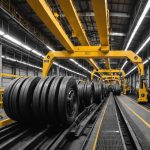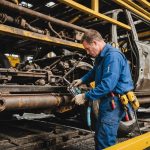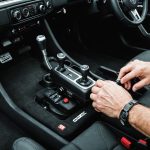Overview of Vehicle Chassis Corrosion
In the automotive world, vehicle chassis corrosion is a serious concern that directly impacts safety and longevity. This type of degradation occurs when metal parts of the chassis are exposed to moisture, leading to rust formation. The degree of corrosion varies, and the severity often depends on environmental factors such as humidity, road salt, and maintenance practices.
Types of Corrosion
Different types of corrosion can affect a vehicle chassis, classified into mild, moderate, and severe. Mild corrosion typically involves surface rust, which is minimal and often just cosmetic. However, without timely intervention, it can progress. Moderate corrosion sees more significant rusting and may cause weakening of the metal structure. Severe corrosion, however, leads to substantial metal loss, compromising the vehicle’s structural integrity and safety.
In the same genre : Mastering Clutch Pedal Free Play: A Comprehensive Guide to Proper Adjustment in Your Manual Transmission Vehicle
Significance of Inspection
The significance of inspection cannot be overstated when it comes to detecting and managing corrosion. Regular inspections are crucial to identify early signs of rust and take preventive measures. This not only ensures safety but also extends the vehicle’s lifespan. By addressing these issues early, vehicle owners can avoid costly repairs and maintain the integrity of their vehicle chassis. It’s a proactive approach that bolsters both vehicle performance and safety.
Inspection Procedures for Chassis Corrosion
Conducting a thorough inspection of your vehicle’s chassis is crucial for detecting corrosion early, which can save you time and money in the long run.
Also to read : Essential Considerations for Optimizing Suspension Settings to Enhance Load Management
Preliminary Inspection Steps
Begin by performing a general visual assessment of the vehicle. Look for any visible signs of rust or damage on the chassis, focusing on areas that are prone to moisture retention, such as wheel wells and the undercarriage. Establishing a comprehensive checklist ensures no vital area is overlooked.
Detailed Inspection Techniques
To accurately identify early-stage corrosion, it is essential to utilize specific techniques. Use a flashlight and mirror to inspect hidden niches and joints where corrosion often starts. Gentle tapping can help detect weak or hollow areas, indicative of metal degradation beneath the surface. Utilizing these methods ensures a more thorough discovery of underlying issues.
Post-Inspection Recommendations
After completing the inspection, compile a detailed report of your findings. Documenting these helps in tracking the progression of corrosion over time, providing valuable insights for maintenance schedules. Additionally, consult a professional for further analysis if severe damage is detected, to ensure necessary measures are taken to protect your vehicle.
Safety Equipment for Corrosion Inspection
When conducting corrosion inspection, ensuring inspection safety is paramount. Inspectors must equip themselves with recommended personal protective equipment (PPE). Essential items include hard hats, safety goggles, and gloves, each contributing to overall protection against potential hazards. Protective gear such as coveralls and steel-toed boots is also crucial, especially in environments where falling debris or chemical exposure may occur.
Inspectors should be aware of essential tools required for a safe inspection. These tools range from flashlights and moisture meters to handheld spectroscopes. Each plays a vital role in detecting and evaluating the extent of corrosion effectively.
Adhering to safety protocols is necessary throughout the inspection process. Before commencing inspection, it’s advisable to conduct thorough site assessments to identify potential risks. Inspectors must be trained in emergency procedures and have access to first aid supplies on site. While conducting inspections, maintaining proper communication with a team enhances safety measures and responds swiftly to unexpected situations. These comprehensive safety practices, paired with the correct protective gear, ensure the well-being of inspectors while facilitating successful corrosion assessments.
Best Practices for Preventing Chassis Corrosion
Protecting your vehicle means being vigilant about corrosion prevention. Regular vehicle maintenance is crucial, ensuring that your car runs smoothly and maintains its value.
Regular Maintenance Tips
Routine cleaning is a first step. Mud, dirt, and debris can accumulate, especially in wheel wells and undercarriage areas. These areas are particularly prone to holding moisture, which can increase rust activity. Inspect your vehicle for any signs of corrosion regularly, enabling early detection and intervention.
Environmental Considerations
Environmental factors play a significant role in chassis corrosion. For instance, road salt used in winter months is corrosive. Humidity and proximity to ocean air are also critical factors. Understanding these will help tailor your maintenance schedule. Parking in garages or shaded areas can also minimise exposure to harsh elements, prolonging your vehicle’s lifespan.
Coating and Treatment Options
Effective coatings can significantly deter corrosion. Applying a rustproofing spray will form a protective barrier against moisture and salt. Regular application ensures ongoing protection. Consider professional undercoating services for an added line of defence. Coating and treatment options may vary, so evaluating according to your vehicle’s specific needs and environmental exposure will ensure optimal corrosion prevention.
Treatment Options for Existing Corrosion
Tackling corrosion requires a strategic approach tailored to its severity. For mild to moderate corrosion, several repair techniques can arrest the damage. Corrosion treatment begins with a thorough cleaning of the affected area to remove loose rust and debris. This often involves using wire brushes or sandpaper, followed by protective coatings to prevent further deterioration.
Professional repair options often involve advanced treatment techniques, such as sandblasting or chemical rust removers, typically more effective for extensive corrosion. These methods demand expertise, ensuring maintenance solutions are applied accurately for long-term results. Professionals may use specialised primers and paints that contain inhibitors, further safeguarding surfaces against future rust.
For those inclined towards DIY approaches, easier and cost-effective maintenance solutions are available. Applying rust converters and protective sprays is straightforward yet effective for smaller issues. However, success hinges on meticulously following product guidelines to ensure treatment solutions are effective.
When treating corrosion, understanding the severity and choosing the right corrosion treatment ensures both longevity and reliability. Properly applied methods, whether DIY or professional, are crucial in maintaining integrity and extending the lifespan of the materials involved.
Relevant Regulations and Standards in Vehicle Maintenance
Staying informed about automotive maintenance regulations is crucial for both professionals and vehicle owners. These regulations ensure safety and efficiency in vehicle operation. They establish criteria that include robust inspection standards tailored to identify potential hazards before they lead to severe issues.
Inspection standards serve as a checklist for evaluating a vehicle’s condition. They often cover aspects such as emission levels, brake performance, and even advanced elements like electronic systems and corrosion inspection. Proper adherence ensures that vehicles are safe to drive and meet environmental standards.
Regarding corrosion inspection and treatment, compliance with standards is vital since untreated corrosion can lead to structural weaknesses. Effective compliance involves routine checks and timely intervention to ensure vehicle longevity.
To stay updated with changes in regulations, engaging with resources and organisations like automotive associations and best practices guidelines is advisable. These entities offer updated information and hold workshops for professionals. Additionally, subscribing to industry newsletters and forums can provide timely updates and insights into best practices guidelines. This proactive approach not only ensures compliance but also fosters industry growth and safety.











